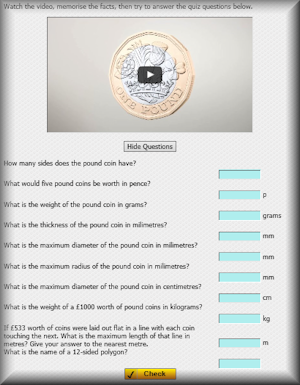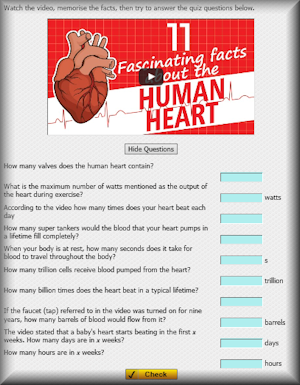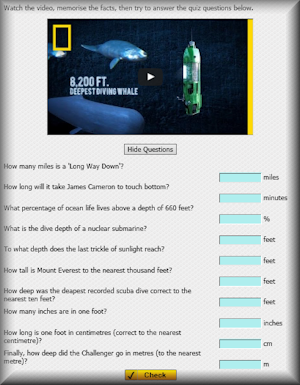Sign In | Starter Of The Day | Tablesmaster | Fun Maths | Maths Map | Topics | More

A reminder of how to add two or more numbers using the column method. [Time: 6:32]

See a demonstration of angles in a full turn around a point, angles together on a straight line and vertically opposite angles.

A reminder of how to use the fact that the angles in a triangle sum to 180 degrees to find the size of unmarked angles in triangular diagrams.

Calculate and solve problems involving perimeter and area of rectangles, triangles, parallelograms, trapezia, kites and composite shapes.

A reminder of how to find the next term, the nth term and the sum of terms of an arithmetic or linear sequence.

Revise how to calculate the mean, median, mode and range from lists and frequency tables.

Find out about bearings and practise estimating, measuring and calculating them.

A reminder of the order of operations often referred to as BIDMAS, BODMAS or PEMDAS. [Time: 13:26]

You may have learnt about the binomial expansion in class some time ago so here's a reminder to bring you up to speed. [Time: 10:06]

Box plots, sometimes called box and whisker diagrams, are a useful way of visualising data.

Learn how to remove brackets from simple algebraic expressions. This video is to help you do the online, self-marking exercise. [Time: 6:17]

Learn how to multiply the terms inside a pair of brackets by the term outside. This video is to help you do the online, self-marking exercise. [Time: 5:37]

Expand a pair of brackets using the clown's face method. This video is to help you do the online, self-marking exercise. [Time: 7:49]

The final video showing how algebraic expressions containing brackets can be simplified. [Time: 7:07]

If you have no dice don't despair because most scientific calculators have a random number generating facility as can be seen in this short video. [Time: 0:40]

Otherwise known as rearranging the formula, this video shows how to change the subject of an equation. [Time 26:02]

The circumference and area of a circle can be found if the radius or diameter are known.

How does the circumference of a glass compare to the height of the glass? You'll be surprised when you find out. [Time: 1:03]

If you have forgotten what collecting like terms means watch this video for a quick refresher. [Time: 7:21]

You may not realise that it is possible to find sin60° or tan45° without a calculator. This video is to help you do the online, self-marking exercise. [Time: 3:12]

Learn the conditions for two triangles to be congruent and then use this information to solve problems. [Time: 9:40]

For those who would like a reminder about coordinates here it is. This video is to help you do the online, self-marking exercises

See the most efficient pencil-and-paper methods for multiplying and dividing decimal numbers. [Time: 26:27]

Learn the written methods for adding and subtracting decimal numbers. This video is to help you do the online, self-marking exercise. [Time: 17:48]

A reminder of how to differentiate different types of functions and how to find the equations of tangents and normals.

A reminder of how to divide one number into another using short or long division. [Time: 21:02]

A short video showing how to find the equation of a line that passes through given points. [Time: 10:41]

If you have learnt how to solve linear equations the next step is to solve equations with fractions.

Learn about equivalent fractions and how to express fractions in their lowest terms. [Time: 17:01]

Here are some examples showing how to express one quantity as a percentage of another. [Time: 8:30]

A reminder of how to factorise an algebraic expression. This video is to help you do the online, self-marking exercise.

Did you know that you can fold an A4 sheet of paper into a regular pentagon? This short video shows how it is done. [Time: 2:13]

See a number of examples of putting decimals and fractions in order of size. [Time: 13:13]

A reminder of the quick methods of converting between fractions, decimals and percentages. [Time: 15:25]

So many people can't remember how to add, subtract, multiply and divide fractions so here is a reminder. [Time: 21:24]

Revise all you need to know about geometric sequences and series. [Time: 12:34]

Learn different methods for finding the highest common factor and lowest common multiple of two or three numbers. [Time: 16:13]

Converting improper fractions to mixed numbers. The video is to help you do the online exercise. [Time: 7:02]

Find out how to change a mixed number into an improper fraction. This video is to help you do the online, self-marking exercise. [Time: 5:12]

Learn how to convert an improper fraction to a mixed number in its lowest terms. [Time: 8:04]

Indices, exponents and powers can all be used as a short way to describe repeated multiplication.

You can't possibly learn all about integration from a 28 minute video so all that this resource can do is provide a quick revision to help you do the online exercise. [Time: 28:02]

Learn about simple interest, compound interest, appreciation and depreciation. This video is to help you do the online, self-marking exercise. [Time: 39:29]

Making a list in a logical order will help you avoid repetition and omission when finding combinations and permutations. [Time: 26:11]

Revise all you need to know in order to complete the Logarithms online exercise. [Time: 15:39]

Refresh your understanding of map scales expressed as ratios. [Time: 17:02]

Kim's Game requires you to remember a number of items and in this version the items are all mathematical. Improve your recall skills by playing along with this three-part memory challenge. [Time: 14:30]

Learn how to use a protractor to measure angles of any size. This video is to help you do the online, self-marking exercise. [Time: 14:11]

Revise the methods for adding, subtracting, multiplying and dividing mixed numbers (fractions) by watching this video. [Time: 15:24]

A reminder of how to multiply two numbers using the column method or long multiplication.

A video showing how to how to add, subtract, multiply and divide negative numbers.

Learn more about three-dimensional shapes and their nets. [Time: 7:44]

When you have mastered working out percentages you can then apply that skill to calculating percentage increase, decrease and reverse percentages.

It is really useful to have some mental strategies for working out percentages in your head. [Time: 10:52]

A step-by-step guide showing how to construct the perpendicular bisector of a line segment.

Revise the concept of place value for whole numbers and decimals. This video is to help you do the online, self-marking exercise. [Time: 13:01]

A concise reminder about angles, both interior and exterior, in regular and irregular polygons.

A reminder of what prime numbers and composite numbers are. [Time: 6:42]

A reminder of how to work out basic probability leading to simple combined events and expected values.

The square of the hypotenuse of a right-angled triangle is equal to the sum of the squares of the other two sides.

Learn the common methods of solving quadratic equations by factorising and by using the quadratic formula. [Time: 58:41]

Learn to work with ratios including dividing a quantity in a given ratio.

This video provides a description of rotational symmetry and shows how I calculate the order of rotational symmetry. [Time: 10:24]

A reminder of how to round numbers to significant figures, decimal places and to the nearest power of ten.

A demonstration of standard ruler and compass constructions. [Time: 3:04]

The scale factor, area factor and volume factor of similar shapes are quite different.

Learn to solve simultaneous equations from the very basic to those containing quadratics. This video is to help you do the online, self-marking exercise. [Time: 36:44]

A short video which explains how to use graphs to solve simultaneous equations. [Time: 7:02]

Learn how to write and calculate with numbers in standard form - sometimes called scientific notation. [Time: 17:38]

After drawing a straight line graph learn about its equation in the form y = mx + c.

Lots of examples of substituting values into algebraic expressions. This video is to help you do the online, self-marking exercise.

A reminder of how to subtract one number from another using the column method. [Time: 8:57]

Learn that a surd is an irrational number and how to simplify expressions including surds. This video is to help you do the online exercise. [Time: 36:20]

Finding the surface are of three dimensional shapes can involve some interesting formulae.

A guided tour through the levels of the Tally Charts online exercise. [Time: 11:36]

Learn how to tell the time from an analogue clock then do the online exercise called Telling The Time Level 1. [Time: 6:24]

Learn how to tell the time from an analogue clock then do the online exercise called Telling The Time Level 2. [Time: 7:02]

Learn how to tell the time from an analogue clock then do the online exercise called Telling The Time Level 3. [Time: 4:34]

Learn how to tell the time from an analogue clock then do the online exercise called Telling The Time Level 4. [Time: 10:12]

When you have mastered trigonometry in two dimensions it is time to practise solving three-dimensional problems. [Time: 19:41]

A demonstration of the four basic transformations: reflection, translation, rotation and enlargement.

Learn about distance-time graphs, speed-time graphs and how to interpret them.

Tree diagrams can be really helpful showing combinations of two or more events in order to calculate probabilities. [Time: 21:28]

The basic trigonometric ratios are sine, cosine and tangent and are used to find the lengths of sides and the size of angles in right-angled triangles.

A reminder of how to find the limits of accuracy of rounded values. [Time: 12:26]

Learn how coordinates can be linked with vectors and how these vectors can help you decide if three points are collinear. [Time: 14:35]

Learn about addition and subtraction of vectors and multiplication of a vector by a scalar. [Time: 23:44]

Here is a demonstration of how to illustrate union, intersection and complement of sets as they appear in Venn diagrams. [Time: 19:35]

There are simple formulas that can be used to find the volumes of basic three-dimensional shapes.

A festive collection of 12 engaging mathematical puzzles, most of which feature their own interactive web pages for an enhanced experience. [Time: 20:32]

Short Futurama clip: Fry's reaction to becoming a billionaire!

A video from Simon Clark presenting a deep but accessible account of the history of pi. [Time: 16:46]

A fast paced animation explaining the development of the modern calendar. [Time: 3:55]

It's not just the squares on the sides of right angles triangles that add up! [Time: 8:56]

Only 10% of people get the correct answer to this simple logic puzzle. [Time: 3:55]

A video explaining how to approach algebraic proof. This is suitable for students on a higher GCSE course. [Time: 31:42]

A song about the angles made with parallel lines. [Time: 2:53]

Craig Barton and Jo Morgan help you and your class understand angles through the means of kung fu. [Time 1:12:49]

This Maths problem went viral on Twitter and there has been debate about the answer. Presh explains why one interpretation is considered correct. [Time: 3:32]

A video showing how binary counting can solve the Tower of Hanoi puzzle. [Time: 13:58]

A novel way of introducing the mathematical calculation convention, BODMAS [Time: 1:27]

Can you use Maths to get you and your friends over the bridge before the zombies arrive? A logic puzzle presented as a cartoon. [Time: 3:49]

This simple Maths problem often baffles even really smart people. Can you solve it? [Time: 0:55]

A teacher draws a perfect freehand circle of diameter one metre in less than a second. [Time: 1:18]

A free trial lesson from Math Upgrade dot com. [Time: 1:51]

This song helps students remember circle terminology (radius & diameter) and the formulas for area and circumference. [Time: 1:36]

Learn how to tell the difference between permutations and combinations and use the formulae to answer questions. [Time: 7:38]

Construction (with compass and straight edge) of a triangle congruent to a given triangle. [Time: 1:33]

Find out how statisticians use density samples to estimate their statistics. [Time: 2:40]

Professor Marcus Du Sautoy believes that the worlds of Mathematics and the Arts are much closer than we’re led to believe [Time: 5:03]

This video from Corbettmaths explains what the term cube root means and shows how to cube root a number. [Time: 3:21]

Chelsea Football Club's Liam Delap calculating cube roots of large numbers in his head. [Time: 0:36]

Mentally calculate the cube root of any perfect cube of a number between 1 and 1000. [Time: 8:39]

Short clip from QI: Stephen Fry demonstrates Pythagoras' theorem.

Euclid and his friends explain how many different kinds of triangle there are. [Time 3:47]

Examples showing how to solve direct and inverse proportion questions in the form of a song! [Time 3:33]

An instructional video from Mr Morley Maths

Domain and range of a function given a formula from Khan Academy. [Time: 8:06]

A Maths teacher goes through the idea of enlarging a shape from a centre of enlargement. [Time: 10:39]

How to enlarge a shape by a positive scale factor and a centre of enlargement. Includes a scale factor less than 1 and a centre of enlargement inside the shape. [Time: 2:27]

Learn how to use the powers of 10 to make amazingly fast estimations of big numbers with this animated explanation. [Time: 4:14]

Mathematician Presh Talwalkar explains five facts you should know about pi. [Time: 5:53]

A straight forward explanation from SLEP [Time: 2:50]

These are the formulae candidates need to know for the GCSE(9-1) Maths exams. [Time 58:11]

A free trial lesson from Math Upgrade dot com. [Time: 1:34]

Screencast of probability lesson for Intermediate GCSE Maths. [Time: 9:37]

A supercut of moments in TV and cinema where characters downtalk maths. [Time: 2:15]

How did they figure out the area of a circle is pi times r squared? A video from Mind Your Decisions. [Time: 11:04]

This video shows how to play War cards tweaked just a little to turn it into a maths game. [Time: 3:55]

Steve Backshall teaches you how to use a compass to take a bearing and find out which direction you need to travel. [Time: 1:33]

Chapel Hill-Chauncy Hall teacher Kelly Overbye demonstrates how she uses Multiple Intelligences, to teach her students about the slope of graphs. [Similar to Transum's Human Graphs] [Time: 1:55]

An in depth look at the topic of indices from beginning to end. [Time 57:41]

A free trial lesson from Math Upgrade dot com. [Time: 2:23]

This video will give you a brief introduction to calculus. It does this by explaining that calculus is the mathematics of change. A couple of examples are presented, and then limits, derivatives, and integrals are introduced. [Time: 4:11]

A really zany video revising mean, median, mode and range [Time: 3:49]

Why do some years have an extra leap day and what is it for? [Time: 3.59]

A cartoon from Smile and Learn with very easy examples of how to find the LCM of two numbers.

A cartoon illustrated rap song explaining addition and subtraction of decimals. [Time: 1:49]

A very clear demonstration of how to use a compass and a straight edge to draw common loci. [Time: 3:38]

Logarithms and log tables - what Transum used before calculators! A Numberphile video. [Time: 5:09]

A basic introduction to the concept of logarithms from the Khan Academy [Time: 9:48]

Introducing Mathino. A number facts card game. [Time: 4:59]

A four-step process for taking pupils on the path from acquisition to automaticity [Time: 5:47]

Mathematical errors in the movies. [Time: 6:47]

A video leading you to loads of exciting, engaging and challenging mathematical investigations.

Some of your favourite maths jokes are dissected in forensic fashion. [Time: 6:59]

Lana Rose sings the song she wrote for GCSE maths revision. [Time: 2:28]

A TED talk describing a visual approach to learning Maths from MIND Research. [Time: 8:17]

A free trial lesson from Math Upgrade dot com. [Time: 1:31]

A quick overview of methods for learning all one hundred multiplication facts from 1x1 to 10x10. [Time 3:58]

This video lesson shows you tips on how to multiply faster than ever! [Time: 10:44]

Ted Talk: Why the metric system matters - Matt Anticole

Some people have some strange ideas about multiplication and division. [Time: 2:12]

Dr. Howard Gardner explains his multiple intelligence theory. [Time: 7:54]

A different way to multiply together numbers. Can you see how it works? [Time: 2:29]

Can you understand the explanation of these multiplication methods even though you may not speak the teacher's language? [Time: 2:34]

Wako shows how to multiply 47 by 83 in his crazy cartoon singing way! [Time 2:58]

A straight forward, no nonsense demonstration of the methods of multiplying and dividing decimals. [Time: 5:02]

An exploration of the terminology, etymology and structure of naming polygons

Cristóbal Vila created this short animated film that deals with geometric formulas that appear in nature such as the Fibonacci Sequence. [Time: 3:44]

A video from MathsWatch about Enlargement by a Negative Scale Factor. [Time: 2:42]

Short but sweet, a Ninja country song about the rules for multiplying directed numbers. [Time: 0:40]

A computationally-efficient, natural, and easy-to-remember algorithm for solving general quadratic equations.

Learn your 9 times table fast using your fingers! [Time: 4:42]

About the Japanese street grid system and other opposites. [Time: 2:48]

Exploring why a full rotation is 360 degrees and, why using radians can be a more useful alternative. [Time: 4:39]

Instructional video showing how the area of a parallelogram can be determined. [Time: 1:34]

A video lesson on Permutations, calculating them using the counting principle and the nPr formula. [Time 13:56]

Some information about Pi, the "celebrity number'. A video features maths-loving author Alex Bellos. [Time:9:42]

Why is The Simpsons not in Base 8? In this video Simon Singh talks about Pi and Maths in The Simpsons cartoon. [Time: 9:39]

Kate Bush sings the digits of pi (audio only). [Time: 9:31]

We write numbers using only ten symbols (called Digits). Where we place them is important. [Time: 2:56]

A Khan Academy video explaining place value. [Time: 3:59]

What are platonic solids and why are there only five of them? [Time: 6:37]

Dividing by zero, zero divided by zero and zero to the power of zero - all pose problems! [Time: 12:59]

This video covers Proof by Mathematical Induction and is from Revision Village

The Simpson's 26th season finale. 'Mathlete's Feat' is full of mathematical problems that Presh solves. [Time: 6:39]

Wheel with liquid demonstrates the Pythagorean theorem at Brentwood. [Time: 19 seconds]

A song from Math Upgrade dot com. [Time: 2:57]

A lively explanation from Math Antics [Time: 8:49]

A demonstration of standard ruler and compass constructions [Time: 3:04]

Maths teachers from England construct a scatter graph from their heights and shoe sizes. [Time: 3:20]

A video explaining how to complete a Venn diagram using sets from 1st Class Maths. [Time: 19:51]

Does seven times thirteen really equal twenty eight? [Time: 2:34]

This video portrays a visual of how to explain the difference between simple interest and compound interest in a very practical way. [Time: 5:51]

This video demonstrates how to solve simultaneous equations by elimination. [Time: 2:51]

Math Tricks for Fast Calculation - How to square numbers between 10 and 20 without memorisation. [Time: 2:31]

This video explains numeric and categorical data and helps you gain an understanding of when to apply a t-test or a chi-square test. [Time: 12:49]

John David Walters shares the origins of mathematical symbols, and illuminates why they’re still so important in the field today.

Marcus du Sautoy' TED talk illustrating some aspects of symmetry. [Time: 20:17]

Using loci in the movies! Two intersecting circles are drawn to find a specific location. [Time: 1:32]

A tetrahedron and a pyramid have edges of equal length. If they are glued together on a triangular face with the vertices aligned, how many faces will the new shape have? [Time: 3:47]

A 50 cent coin has 12 equal sides. If you place two coins next to each other on a table, what is the angle formed between the two coins?

Complex data sets (like military spending, media buzz, Facebook updates) are turned into beautiful, simple diagrams. [Time: 18:17]

A fascinating BBC Two television programme from 1986. A documentary on Leibniz and the calculus. [Time: 24:43]

The Counting Principle, Permutations, and Combinations. A fast paced, clearly illustrated video.

Explore the astonishing power mathematics across the centuries in this video from PBS. [Time: 53:21]

A visual riddle! Can you explain? [Time: 0:54]

An excerpt from the animated film American Dream [Time: 3:04]

Arthur Benjamin gives a TED talk on Fibonacci numbers. [Time: 6:24]

Enjoy learning about the origins of words like "inch" and "furlong". A video from Robwords [Time: 20:37]

An illustrated talk about the notion of symmetry and how it applies to nature. [Time: 5:08]

This video from Mind Your Decisions teaches a trick so you can solve the puzzle quickly.

This is a video of a presentation introducing the TI-Nspire CS CAS calculator. [Time 11:15]

Time Calculations using Casio Calculator using the Degrees, Minutes and Seconds button. [[Time 3:23]]

What is a second the "second" of? What time should noon actually be? A video about the vocabulary of time from Robwords [Time: 22:00]

Jill Mansergh uses a number stick to teach the 17 times table in less than ten minutes. [[Time: 9:07]]

The four basic transformations have been put to music! [Time: 2:26]

A trigonometry and Pythagoras theorem revision song [Time: 3:31]

Want to know how to use your scientific calculator? We thought this might be useful - here's an easy to follow, step by step guide. [Time: 13:00]

Hans Rosling's famous lectures combine enormous quantities of public data with a sport's commentator's style to reveal the story of the world's past, present and future development. [Time: 4:47]

A basic introduction to the concept of functions. [Time: 11:33]

A light-hearted look at percentages from Math Antics. [Time: 8:52]

The one thing physicists, air traffic controllers, and video game creators all have in common! An animated Ted Ed talk by David Huynh. [Time: 4:40]

Dr James Grime discusses e - the famed Euler's Number. [Time: 10:41]

This video looks at where English got its numbering system. A video from Robwords [Time: 21:07]

How long can Santa spend at each home delivering presents? This and other festive questions answered. [Time: 3:58]

Did you know there is a formula for calculating the amount of wrapping paper needed? [Time: 4:21]

Memorise the mathematical facts in the video then answer the ten quiz questions to earn a trophy.
A selection of short (one to two minutes) factual videos have been chosen for this test of memory. When the video has finished playing reveal the questions based on the video. The first questions test recall while the latter questions require application of the facts. Click on one of the images below to begin.
The Pound Coin |
The Human Heart |
Long Way Down |

The mathematical factoids you never knew that you never knew. What is a googol? Who invented the equals sign? Which number comes first if they are arranged alphabetically? What is the answer to the ultimate question of life, the universe, and everything? What is the maximum number of moves it will take to solve a Rubiks cube no matter which of the 43 quintillion possible starting positions you begin with? Click on the picture to the left to find out.